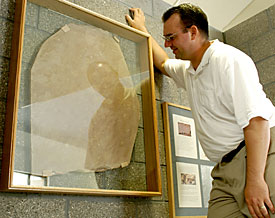 |
|
Joshua Sills\Arizona Daily Wildcat
|
Greg Cranwell inspects a piece of flagstone containing the footprints of a 270 million year old mammal. Cranwell found the footprints at Pima Community College East campus.
|
|
|
By Ashley Nowe
Arizona Daily Wildcat
Tuesday August 26, 2003
UA senior finds 270 million-year-old print in Pima breezeway
Greg Cranwell, a UA senior, has a habit of looking down at the ground wherever he walks, but he usually only notices the texture of the floor and the dirt tracked in by shoes.
As Cranwell, who is also a research associate at the Mesa Southwest Museum, left his physics class at Pima Community's College's East Campus one day last spring, he noticed something unusual in the stone floor.
"I was looking down at the flagstone and thought I saw something," Cranwell said of the discovery he made last spring semester. "I was unsure but I thought ╬what's it going to hurt if I just look.'"
Cranwell's odd habit had landed him a big discovery ¸ 270 million-year-old footprints.
"I ran to the campus president and told her that we needed to get this thing out immediately and she said that with a little more convincing she would have the slab pulled," Cranwell recalled.
Although he has no degree in paleontology, this is Cranwell's second major find.
 |
|
I was looking down at the flagstone and thought I saw something. I was unsure but I thought 'what's it going to hurt if I just look.
- Greg Cranwell,
UA senior
|
 |
In May 2001 he discovered dinosaur bones 25 miles outside of Tucson.
Just as he had researched the history behind the bones, Cranwell began to dig into the specific origins of the footprints.
Over the next few months Cranwell spent hours pouring over numerous photographs of the tiny prints, comparing them with tracks already documented. He was able to narrow down the possibilities by measuring the stride of the creature and the width of its markings.
"It was like comparing apples and oranges," Cranwell explained. "It doesn't take a genius to know if the prints match or not."
After sending photos of the prints to paleontologists across the state Cranwell was able to confirm that they belonged to a mammal-like animal called a chelichnus duncani.
The animal, roughly one foot in size and reptilian in appearance, roamed the dunes located in northern Arizona during the Permian Period, the last period before the rise of dinosaurs, Cranwell said.
Though other chelichnus duncani prints have been spotted, none were quite as clear as the ones Cranwell found, said John Zumbrunnen, environmental technology specialist at Pima Community College.
"It was just as though the sand were wet and it happened today," Cranwell said. "I spent a half an hour just staring at it in awe."
The tracks changed direction and distinct claw imprints could be seen, which is an enormous rarity.
"I was so excited when Greg showed me the prints that I called over one of my students walking by and said ╬Here look at these tracks'," Zumbrunnen said.
The clarity of these prints tells a lot about the animal, such as the way it walked, moved and what the environment was like at the time, said Karl Flessa, UA geosciences professor.
"Similar tracks have been documented," Flessa said. "But it is neat that he made the discovery in a decorative slab of flagstone."
Cranwell said that he hopes his success encourages others.
"If you have a dream, go for it." Cranwell said. "Do whatever it is you love to do."
Cranwell's discovery can be seen in the main lobby at the Pima Community College's East Campus, 8181 E. Irvington Road.
